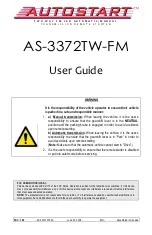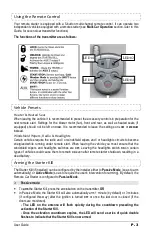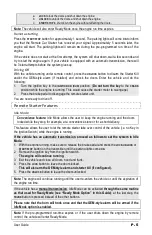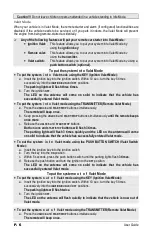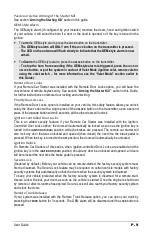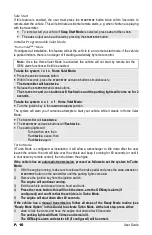
P. 14
User Guide
STATUS
SEQUENCE
LED #1
LED #2
LED #3
LED #4
Beep(s)
1
st
sequence
if unlocked
X
3 flashes
X
X
2
2
nd
sequence
X
X
X
4
4
Table 2
Status Request When the Engine is Running
When the vehicle doors are locked:
The LED # 1 will flash 3 times to denote that the vehicle’s doors are locked.
When the vehicle doors are unlocked:
The LED # 2 will flash 3 times to denote that the vehicle’s doors are unlocked.
RUN TIME
Beep(s)
LED #1
LED #2
LED #3
LED #4
If there is more than 3/4 of run
time cycle
3
ON for 1-sec
ON for 1-sec
ON for 1-sec
ON for 1-sec
If there is more than half of
run time cycle
3
ON for 1-sec ON for 1-sec
ON for 1-sec
X
If there is more than 1/4 of run
time cycle
3
ON for 1-sec ON for 1-sec
X
X
If there is less than 1/4 of run
time cycle
3
ON for 1-sec
X
X
X
Table 3
Troubleshooting Poor Transmitting Range
Many factors may affect the operating range of the transmitter. Some of these are:
•
The condition of the battery in the transmitter.
•
The operating environment (for example: downtown radio-frequency noise, airports, cellular
phone towers…).
•
Metal: any type of metal will affect operating range. This includes the vehicle itself.
•
The shape of the vehicle can affect range as well (vans in general have less range).
•
The shape of the roof and A-pillars brings about considerable radio-frequency deflection (in
this case, the signal from the remote control). As a result, the direction in which the vehicle is
facing in relation to the remote control can affect the range. Straight on (standing in front of
the vehicle) generally gives you the greatest range; the second best performance is from the
back. Using the remote control from either side of the vehicle will usually give the lowest
range.
•
The range will be significantly lower in a crowded parking lot than in open space.
•
Always hold the transmitter high, approximately at shoulder height.
•
The operating range will be somewhat lower on vehicles equipped with an aftermarket or
factory alarm.

